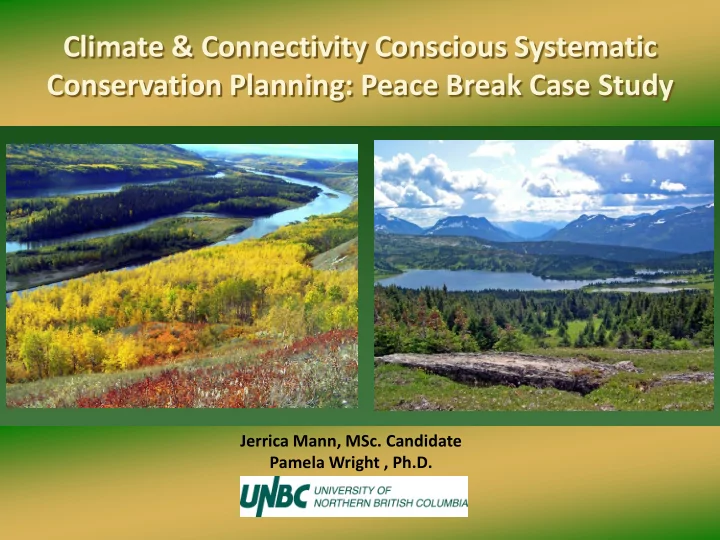

Climate & Connectivity Conscious Systematic Conservation Planning: Peace Break Case Study Jerrica Mann, MSc. Candidate Pamela Wright , Ph.D.
Systematic Conservation Planning (SCP) and Climate Change • Growing development and adoption of SCP (although not yet widely used in practice in NA by gov’t agencies) • Connectivity planning limited but importance (particularly given CC) increasingly recognized • SCP has had limited integration of climate change –tendency for approaches to be more static • Wide-scale, accessible climate change data only recently available in metrics that make sense for SCP….at same time approaches to connectivity analysis becoming more rigorous
Opportunity • CC approaches vary from land facet (preserving the stage) to climate velocity, biotic velocity, climate refugia and novel ecosystems • Currently undertaking SCP for Peace Break area (Ian Curtis with Y2Y) – using a coarse/fine filter analysis incorporating a ‘land facet’ approach • Opportunity to develop and compare approaches for climate conscious planning with explicit consideration of connectivity and assess the feasibility of approaches for broader adoption
Peace Break • Critical importance for connectivity regionally and continentally • Unique E/W connection across continental divide • High value conservation targets including caribou, grizzly, bull trout etc • Resource values high and threat extreme • Current levels of protection very low – conservation window closing rapidly • Already working on SCP there in partnership with Y2Y and others
Research Questions (1) What are the probable future climate conditions for the PB? (2) What characterizes a climate resilient landscape and what elements of climate resiliency should be selected to guide conservation planning in the PB? (3) How do high priority sites for landscape level conservation in the PB differ between a static biodiversity-based approach, and a climate resiliency based approach to conservation area design?
Approach and Status Compile data – develop current/future footprint Identify conservation goals (coarse/fine filter and climate change resiliency and refugia) Determine extent to which existing reserves (existing PA’s and proposed portfolio selection) achieve conservation targets Use Marxan ILP identify proposed portfolio of lands that achieve conservation targets at minimal cost (cost = least footprint) Use OmniScape to quantify landscape permeability and resistance Use Marxan ILP to generate a portfolio of additional lands using climate conscious metrics Compare portfolio of lands selected using traditional SCP practices (but including land facet coarse filter layer) and those created using climate conscious SCP approach
Historic, Current and Future Human Footprint Forest Harvest in the PRB Study Area between 1941 and 2016 40000 y = 452.28x + 1174.1 35000 Area (Hectares) R² = 0.7897 30000 25000 20000 15000 10000 5000 0 1941 1950 1956 1959 1962 1965 1968 1971 1974 1977 1980 1983 1986 1989 1992 1995 1998 2001 2004 2007 2010 2013 2016 Year Juri Peepre
SCP Selection Portfolio of Conservation Lands in Current Context
Building a Climate Resistance Cost Surface Use OmniScape to identify landscape resistance due to human modification, geophysical barriers, and climate Example OmniScape mapping from NCC dissimilarity application in the Pacific NW. (Mcrae et al 2016)
Climate Metrics • Climate velocity is one of the most widely used metrics for estimating exposure. • Climate velocity tells us the direction and rate at which organisms must move to maintain a given climate. • It is calculated by dividing the rate of climate change by the rate of spatial climate variability. • Univariate or Multivariate • Forward or Backward AdaptWest Climate Velocities
Climate Metrics AdaptWest Climate AdaptWest Climate Velocities Velocities Sites Species & Populations
Climate Metrics • Disappearing Climates • Novel Climates & Ecosystems • Refugia • Biotic Velocities vs Climate Velocities
Next Steps • OmniScape – resistance surfaces and develop as a cost layer • Revise portfolio selection • Comparison of two approaches
Questions?
Recommend
More recommend